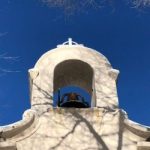July 12, 2020
If your eye is healthy, your whole body is full of light. (Luke 11:34).
All religious teachers have recognized that we human beings do not naturally see; we have to be taught how to see. ~ Richard Rohr
Last week my son Ro and I went backpacking for two days and two nights in the Bear Creek Basin area. For the first twenty-four hours we saw one other person. The quiet and sheer natural beauty of the La Plata mountains was divine. The first night we camped on a high ridge above 10,00 feet. The green tundra, the subtle mountain flowers, and the unobstructed views of the jagged peaks of Hesperus, Centennial, Sharkstooth to the west and the endless San Juan Mountains to the east simply filled our souls with beauty.
While basking in the alpenglow, I looked down and noticed a small piece of plastic that some previous hikers casually left behind. I saw a metal tab to a can. Who could be so thoughtless and careless? Who would walk all the way up here and leave their trash? The answer…me. The sun was setting along with my inner glow. I placed the two small pieces of trash in my pack and looked out once again at the divine beauty all around me.
Father Richard Rohr says, “All religious teachers have recognized that we human beings do not naturally see; we have to be taught how to see.” What forms our eyesight? What influences how we see? What does it mean to see the world and people through the eyes of our Creator?
Father Ron Rolheiser shares a parable from our wisdom traditions that sheds some light on how we see that I would like to paraphrase.
A fit young man walked down a country lane one day and saw a plump disheveled monk sitting under an oak tree. The young man was appalled and said, “You look like a pig!” The monk serenely looked up and said to the young man, “You look divine. You look like the face of God.”
The young man was startled by the monk’s response and asked, “Why do you say I look divine? How could you say such a thing especially when I just insulted you?” The monk replied, “Well, we don’t really see what’s outside of ourselves, we see what’s inside of us and project it out. I sit under this oak tree every day and think about God, the Divine. I dwell on God’s love, joy, and beauty so that when I look out, that is what I see. And you, you must be thinking about other things.”
When we sit under our oak tree, what do we think about? What do we ruminate on? What do we dwell on? What do we play over and over in our minds? Do our thoughts influence our sight? Do they influence how we see the world and people?
If our eyes are healthy, if our eyes are rooted in divine love, then our whole body is full of light; but if it is not healthy, our body is full of darkness, (see Luke 11:34). Sometimes, no, quite often, I obsess on the small piece of trash at my feet. It is not that I should not see the trash, but my obsession with it prevents me from seeing all that is good, wonderful, and divine around me. I/we can easily obsess on the darkness so much that we cannot see the light. “We have to be taught how to see,” says Rohr.
How do we see? What do we focus on?
Rolheiser says there is a philosophic axiom that claims that the way we perceive, and judge is deeply influenced and shaped by our own interiority. This is why five people can see the same thing but have vastly different versions of what happened. “How we perceive others speaks volumes about what is going on inside us,” says Rolheiser. I say, “Ouch!” Jesus says, “You are the light of the world; let your light shine before others,” (Matthew 5:14 and 16).
What is going on inside of us that influences or colors how we see people and the world? The answer requires a lot of prayer, grace, and introspection on our part.
Because Jesus knew his father’s blessing (with you I am well pleased), he was able to live out of a blessed consciousness. Jesus saw the goodness in the thief of the cross, the woman at the well, and the demon-possessed man, his disciples, and I would say everyone. Much like the monk in our parable, Jesus saw God’s image in all people. “His sense of being blessed formed his eyesight,” says Rolheiser.
Sadly, for many of us, we do not know we are blessed or that we are deeply loved so we only look at the world through the lens of irritation, bitterness, or judgment. Constant criticism of others. The Good News is God continues to love us until we know we are blessed. Then, God keeps on loving us lest we forget.
May we see the world with the eyes of Christ.
May we sit under our oak tree and soak up God’s love, joy, and peace.
May we bless people more than we curse people.
May we see the alpenglow in our hearts and in our neighbors’ hearts.
May we be light in the world.
Blessings and peace,
Craig
It is easy to see what is wrong, anyone can criticize another person’s faults or shortcomings, but take time this week to see what’s right, good, and beautiful in someone. Maybe even yourself.

